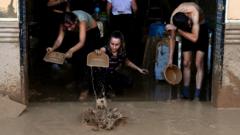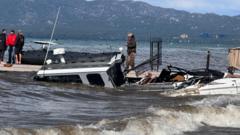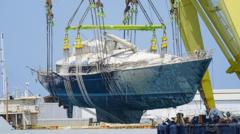In the wake of devastating flash floods that claimed 222 lives in Valencia, a second "Dana" weather system is set to hit eastern and southern Spain once again, prompting multiple alerts and precautionary measures across affected regions.
Spain Faces New Weather Challenges as Torrential Rain Approaches Mediterranean Coast

Spain Faces New Weather Challenges as Torrential Rain Approaches Mediterranean Coast
Spain prepares for more severe weather as a new storm system threatens to bring torrential rainfall, compounding the difficulties already faced by many.
Following two weeks of recovery from the disastrous floods at the end of October, Spain's meteorological agency Aemet has issued orange alerts for the Valencia, Catalonia, and Andalusia regions, along with the Balearic Islands, as the country braces for yet another round of torrential rain and low temperatures. The alert is particularly concerning for eastern and southern Mediterranean areas, which are deemed most vulnerable to the approaching system.
Aemet's warning indicates that the storms could be “very strong to torrential,” leading to significant impacts on daily activities. This weather pattern—known as "Dana"—occurs when a low-pressure area becomes cut off from the jet stream, resulting in prolonged precipitation as cold and warm air collide in the atmosphere.
Precautionary measures have been taken in several towns, with some schools and sports activities suspended, and sandbags placed strategically to mitigate flooding. Despite the harsh reality the region faces, Aemet assures that this storm is not expected to match the disastrous impact of last month's red alert when Valencia experienced unprecedented flooding that resulted in numerous fatalities.
Heavy rains have already affected areas throughout Andalusia, with emergency services rescuing individuals trapped by rising waters. The national traffic office has advised residents to remain vigilant and avoid risky areas, underscoring the ongoing threat posed by potential flooding even in seemingly dry regions.
Amid the stress these severe conditions bring, King Felipe VI is set to visit rescue operations in Valencia, where discontent toward the government's response to the recent crisis remains palpable. Demonstrations have erupted over perceived deficiencies in aid following the earlier catastrophe, with public sentiment growing critical of regional leadership.
Although Dana weather systems typically strike Spain 10 to 20 times a year, this recent series of storms adds an additional layer of urgency in the face of previous disasters. Although meteorologists project this second system will not be as extreme or slow-moving as its predecessor, considerable rainfall—potentially reaching up to 180mm—could still bring new challenges, alongside heavy winds and hail.
As colder air moves across the Iberian Peninsula, several mountainous areas also expect their first significant snowfall of the season. This challenging combination of weather patterns reinforces Spain's need for robust emergency responses as communities work to recover from past disasters while facing further threats from nature.
Aemet's warning indicates that the storms could be “very strong to torrential,” leading to significant impacts on daily activities. This weather pattern—known as "Dana"—occurs when a low-pressure area becomes cut off from the jet stream, resulting in prolonged precipitation as cold and warm air collide in the atmosphere.
Precautionary measures have been taken in several towns, with some schools and sports activities suspended, and sandbags placed strategically to mitigate flooding. Despite the harsh reality the region faces, Aemet assures that this storm is not expected to match the disastrous impact of last month's red alert when Valencia experienced unprecedented flooding that resulted in numerous fatalities.
Heavy rains have already affected areas throughout Andalusia, with emergency services rescuing individuals trapped by rising waters. The national traffic office has advised residents to remain vigilant and avoid risky areas, underscoring the ongoing threat posed by potential flooding even in seemingly dry regions.
Amid the stress these severe conditions bring, King Felipe VI is set to visit rescue operations in Valencia, where discontent toward the government's response to the recent crisis remains palpable. Demonstrations have erupted over perceived deficiencies in aid following the earlier catastrophe, with public sentiment growing critical of regional leadership.
Although Dana weather systems typically strike Spain 10 to 20 times a year, this recent series of storms adds an additional layer of urgency in the face of previous disasters. Although meteorologists project this second system will not be as extreme or slow-moving as its predecessor, considerable rainfall—potentially reaching up to 180mm—could still bring new challenges, alongside heavy winds and hail.
As colder air moves across the Iberian Peninsula, several mountainous areas also expect their first significant snowfall of the season. This challenging combination of weather patterns reinforces Spain's need for robust emergency responses as communities work to recover from past disasters while facing further threats from nature.



















